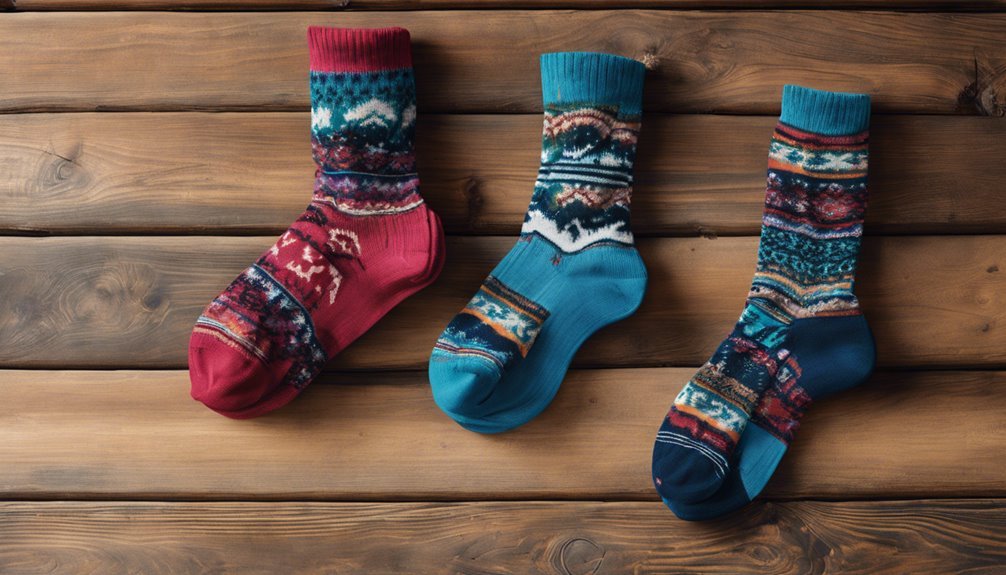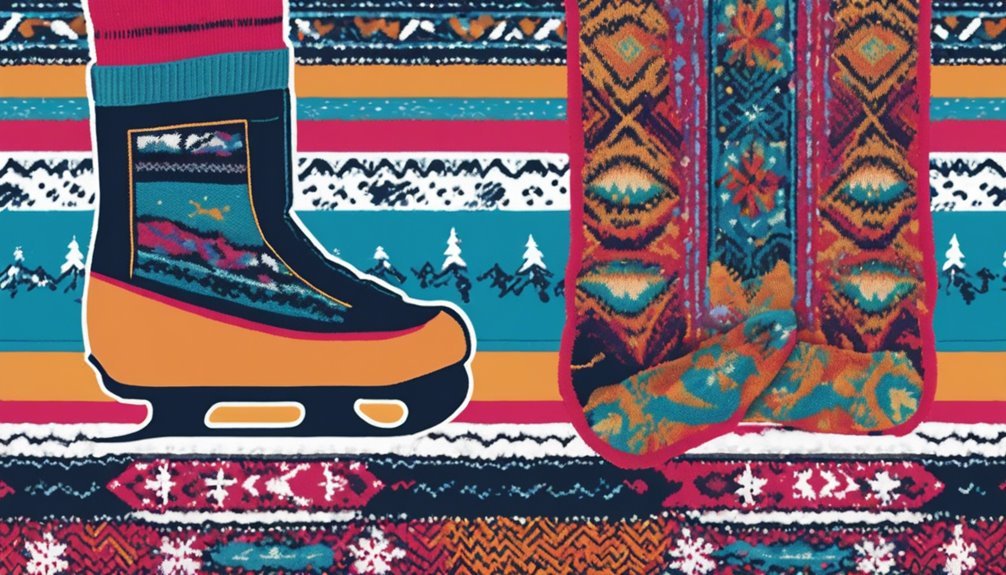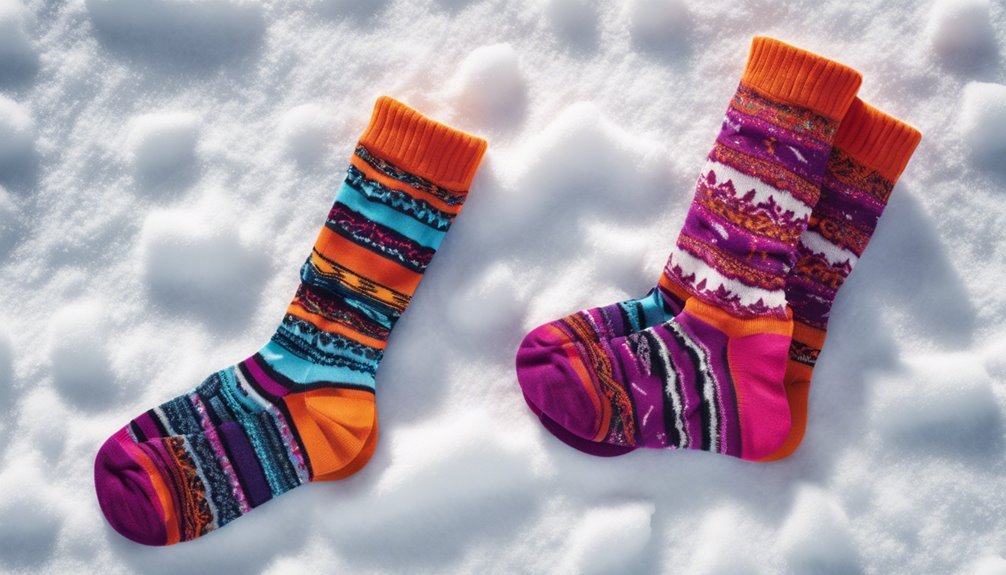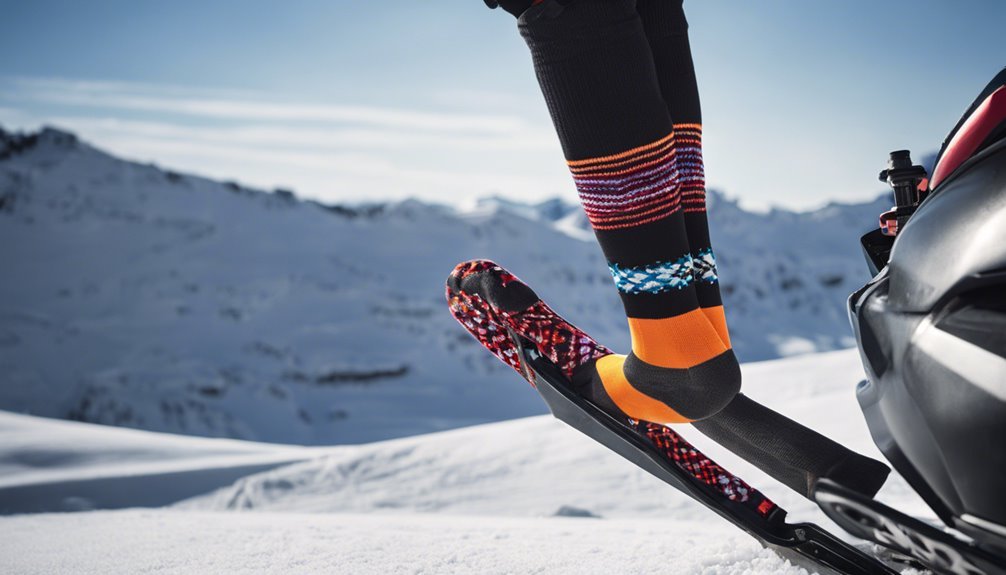Ski Socks vs. Snowmobile Socks: Which Offers More Insulation?
When it comes to insulation, snowmobile socks usually offer more warmth compared to ski socks. Their thicker construction and added padding are designed for prolonged exposure to cold environments, making them ideal for extended snowmobiling trips. On the other hand, ski socks prioritize breathability and moisture-wicking properties for comfort in ski boots. Understanding the differences in design and material can help you choose the right sock for your next winter adventure. Explore more details to guide your choice.
Understanding the Purpose of Ski Socks

When you hit the slopes, understanding the purpose of ski socks is essential for maximizing your comfort and performance. Ski sock benefits go beyond just warmth; they provide cushioning, moisture-wicking, and support, ensuring your feet stay dry and comfortable during long runs. Look for ski sock features like arch support and reinforced heels, which help reduce fatigue and blistering. The right socks also offer a snug fit, preventing bunching that can lead to discomfort. By choosing high-quality ski socks, you not only enhance your skiing experience but also protect your feet from the harsh elements. Investing in the right pair lets you focus on the thrill of the descent, enjoying the freedom of the mountain without distraction.
Understanding the Purpose of Snowmobile Socks
When you're out on a snowmobile, the right socks can make all the difference in your comfort and performance. Snowmobile socks are specifically designed with unique material compositions that enhance fit and temperature regulation, ensuring your feet stay warm without sacrificing mobility. Understanding these features is key to choosing the best pair for your winter adventures.
Material Composition Differences
Although both ski socks and snowmobile socks are designed for cold weather activities, their material compositions differ markedly to cater to the specific needs of each sport. Ski socks often use a blend of merino wool and synthetic fibers for enhanced moisture management, ensuring your feet stay dry and warm during high-energy movements. In contrast, snowmobile socks typically incorporate thicker insulation and durable fabrics like nylon or polyester to withstand prolonged exposure to cold and moisture.
| Fabric Type | Intended Use |
|---|---|
| Merino Wool | Skiing, moisture management |
| Synthetic Blends | Skiing, flexibility and warmth |
| Nylon | Snowmobiling, durability |
| Polyester | Snowmobiling, insulation |
| Blends (Wool/Synthetic) | Versatile use, comfort |
Understanding these differences helps you choose the right gear for your winter adventures.
Fit and Comfort
To guarantee maximum comfort and performance during long hours on a snowmobile, the fit of your socks is essential. Poor sock sizing can lead to discomfort, blisters, or even cold feet, which can ruin your ride. Snowmobile socks are designed to hug your feet without being restrictive, ensuring that you can move freely while maintaining warmth retention. Look for socks that offer a snug fit around the arch and ankle, as this enhances stability and reduces bunching. Additionally, consider options with cushioning in key areas for added comfort during bumpy rides. A well-fitted sock not only boosts your overall experience but also allows you to focus on the thrill of the ride, keeping you warm and carefree on the trails.
Temperature Regulation Features
While you might not think about socks beyond fit and comfort, temperature regulation is a crucial aspect of snowmobile socks that can greatly impact your riding experience. These specialized socks incorporate advanced features to keep your feet warm and dry, allowing you the freedom to ride without distraction.
Consider these temperature control mechanisms and moisture management techniques:
- Thermal Insulation: Keeps warmth close to your skin.
- Breathable Fabrics: Promotes airflow to prevent overheating.
- Wicking Properties: Draws moisture away, keeping feet dry.
- Strategic Padding: Provides insulation where it's needed most.
With these features, snowmobile socks can enhance your comfort and performance, letting you embrace the thrill of the ride.
Key Materials Used in Ski Socks
When it comes to choosing the right ski socks, understanding the key materials can make all the difference in your comfort and performance on the slopes. Merino wool is a top choice for its exceptional warmth and moisture-wicking properties. It keeps your feet dry while providing a soft, itch-free feel that prevents blisters. On the other hand, synthetic fibers like nylon and polyester offer durability and enhanced breathability. These materials are often blended with merino wool to create socks that strike the perfect balance between insulation and moisture management. By knowing these materials, you can select socks that not only keep your feet warm but also allow you to enjoy the freedom of movement needed for an exhilarating day on the mountain.
Key Materials Used in Snowmobile Socks

Snowmobile socks are crafted with specific materials that cater to the unique demands of the sport. You'll want socks that provide warmth while allowing your feet to breathe, ensuring comfort during those thrilling rides. Here are some key materials you'll find in snowmobile socks:
- Merino Wool – Excellent for insulation and moisture management.
- Synthetic Blends – Offers durability and quick-drying properties.
- Nylon Reinforcements – Adds strength and enhances breathability.
- Thermal Fleece – Provides an extra layer of warmth without bulk.
These materials work together to keep your feet dry and comfortable, allowing you to focus on the freedom of the ride. When you're out in the snow, trust in snowmobile socks to deliver the performance you need.
Thickness and Cushioning Differences
Choosing the right socks isn't just about materials; thickness and cushioning play considerable roles in comfort and performance on the snow. Ski socks typically feature thinner designs, optimizing breathability and fit within your ski boots, while offering varying cushioning levels to target pressure points. Snowmobile socks, on the other hand, often showcase greater thickness variations, providing extra padding for those long rides and impacts associated with off-trail adventures. This added cushioning can notably improve comfort during extended periods in the cold. Ultimately, your choice should align with your activity—if you crave agility and precision, lean towards ski socks; if you prefer warmth and protection, snowmobile socks might be your best bet. Choose wisely, and enjoy your freedom in the snow!
Insulation Properties and Performance
The insulation properties of ski and snowmobile socks are essential for maintaining warmth and comfort in frigid conditions. Both types use innovative insulation techniques, but they cater to different activities, influencing their performance comparison. Here's what you should consider:
- Material Composition: Wool, synthetic blends, or a mix—each affects heat retention.
- Moisture-Wicking Ability: This keeps your feet dry, preventing chilling.
- Fit and Compression: A snug fit enhances circulation, boosting warmth.
- Breathability: Essential for regulating temperature during active use.
Choosing the right sock can elevate your experience, making those snowy adventures more enjoyable. Whether you're skiing down slopes or cruising on a snowmobile, understanding these insulation properties can help you stay cozy and free to explore the winter landscape.
Choosing the Right Sock for Your Activity

When you're gearing up for a day on the slopes or a snowmobile adventure, selecting the right sock can make all the difference in your comfort and performance. Ski socks are often made from merino wool or synthetic blends, providing warmth and moisture-wicking properties essential for high-energy activities. On the other hand, snowmobile socks prioritize thicker padding and insulation, catering to those extended hours in frigid conditions. Consider your activity type: if you're carving through powder, opt for a lighter, breathable sock; if you're seated for long stretches, go for something with more cushioning and warmth. By choosing the right sock materials tailored to your adventure, you'll enjoy greater freedom and focus on the thrill ahead.
Frequently Asked Questions
Can I Use Ski Socks for Snowmobiling?
You can use ski socks for snowmobiling, but they might not provide the best insulation. Snowmobile sock features like extra cushioning and moisture-wicking materials enhance comfort and warmth during your ride, so consider those options.
How Do I Wash and Care for My Ski Socks?
To wash your ski socks, use gentle washing techniques. Opt for cold water and a mild detergent, ensuring you respect the sock material. Avoid fabric softeners; air dry them to maintain their performance and longevity.
What Size Ski Socks Should I Buy?
When it comes to sock sizing, you'll want to find that perfect fit for ideal insulation levels. Consider your shoe size and preferred snugness; a well-fitted sock enhances comfort and performance on the slopes.
Are There Specific Brands Recommended for Ski or Snowmobile Socks?
When choosing socks, look for brands like Smartwool and Darn Tough. Their sock materials provide excellent insulation levels, ensuring your feet stay warm and comfortable during your outdoor adventures. You deserve that freedom to roam!
Do Ski Socks Come With Waterproof Options?
Ski socks can indeed come with waterproof options, designed with advanced waterproof materials. While they provide varying insulation levels, choosing the right pair guarantees your feet stay dry and warm during those exhilarating adventures.







